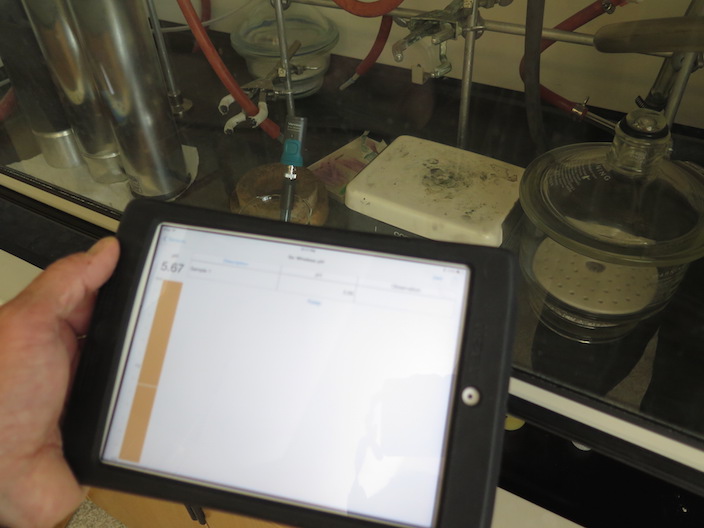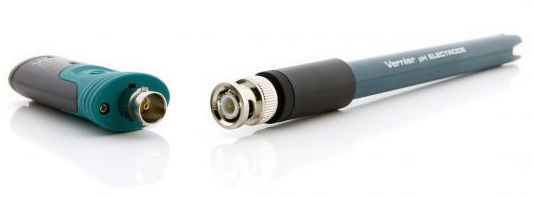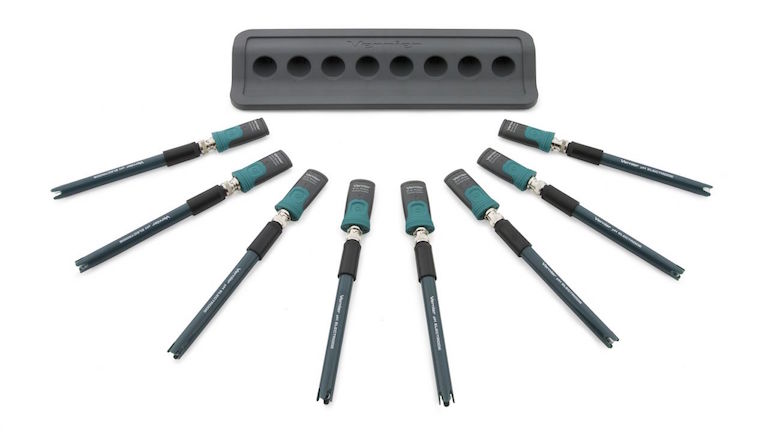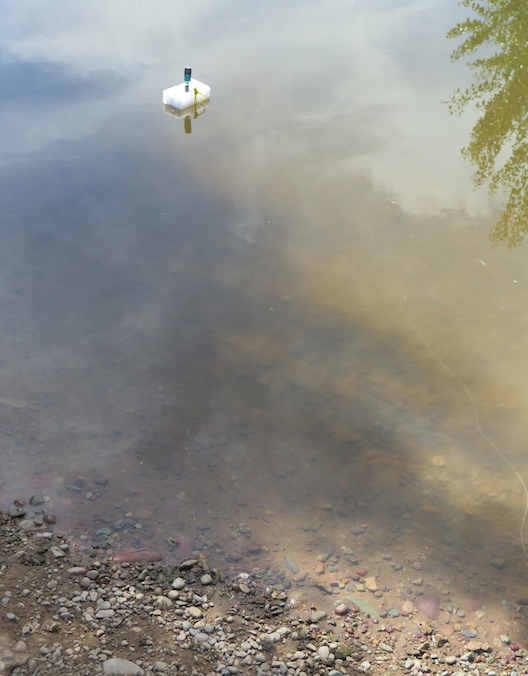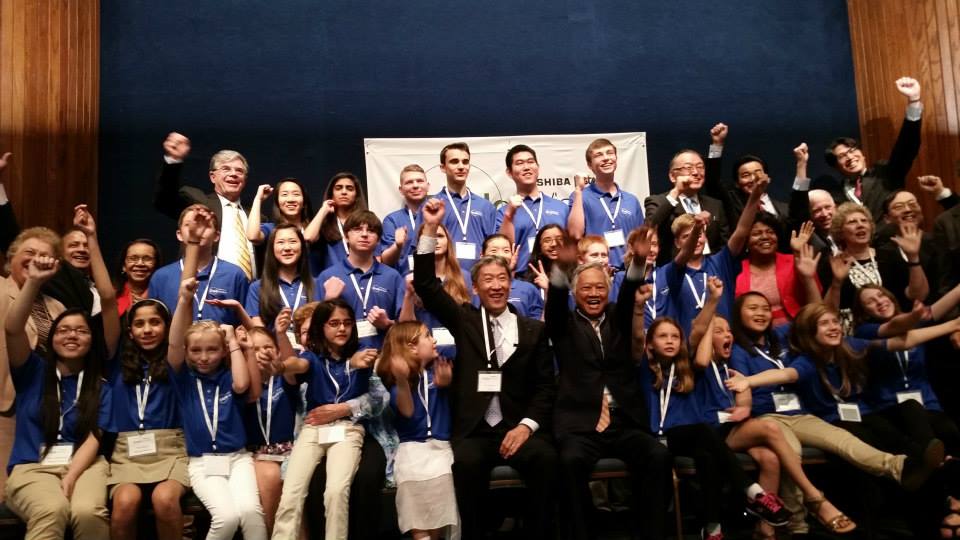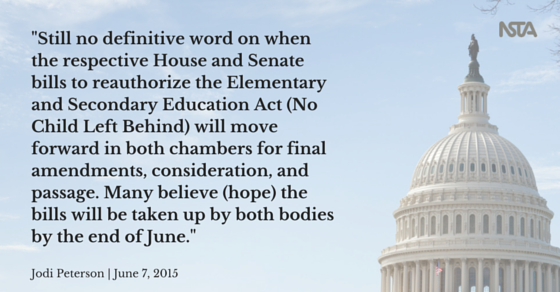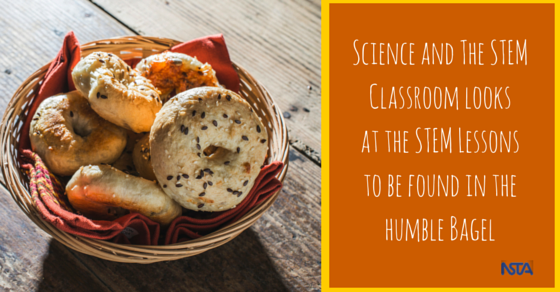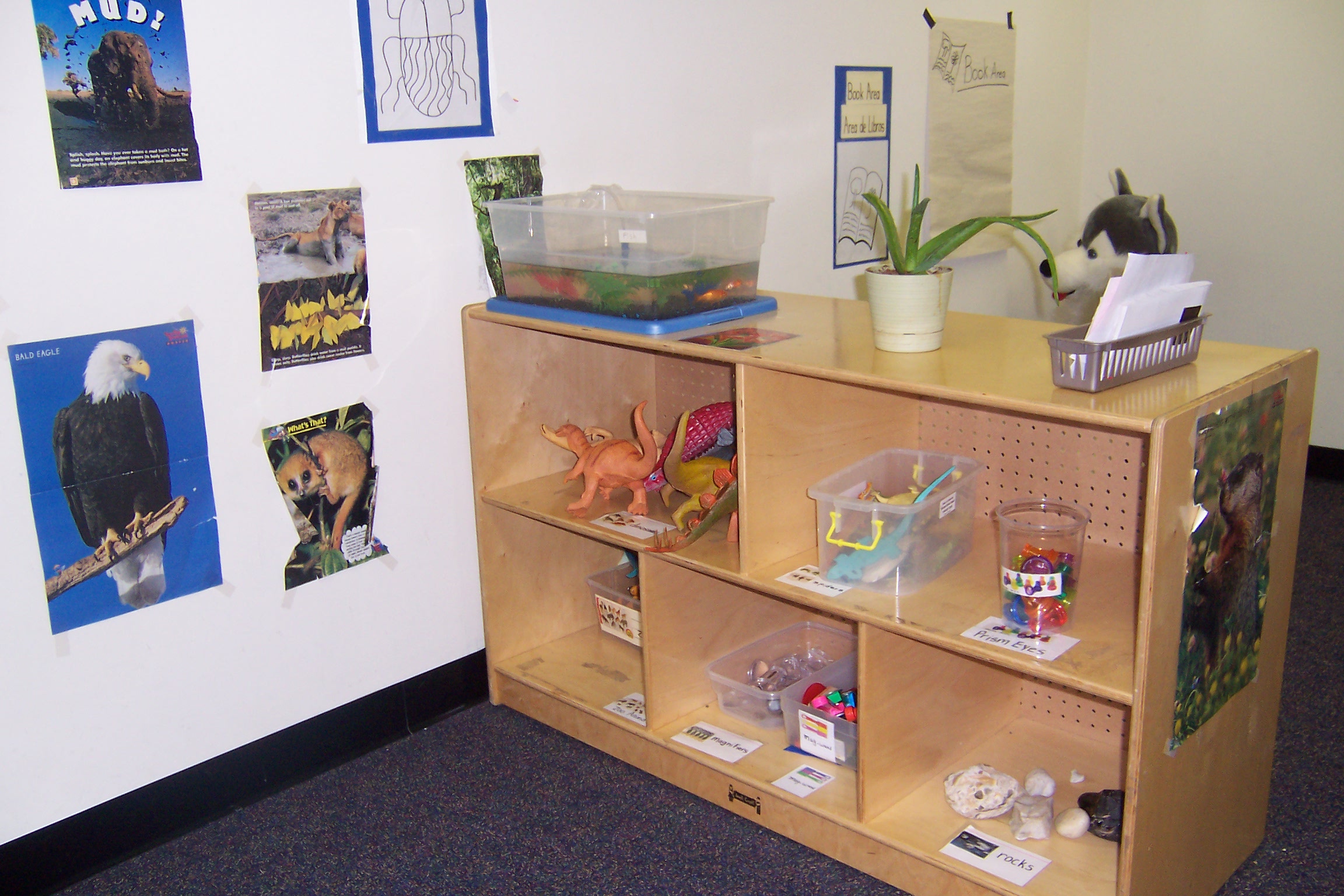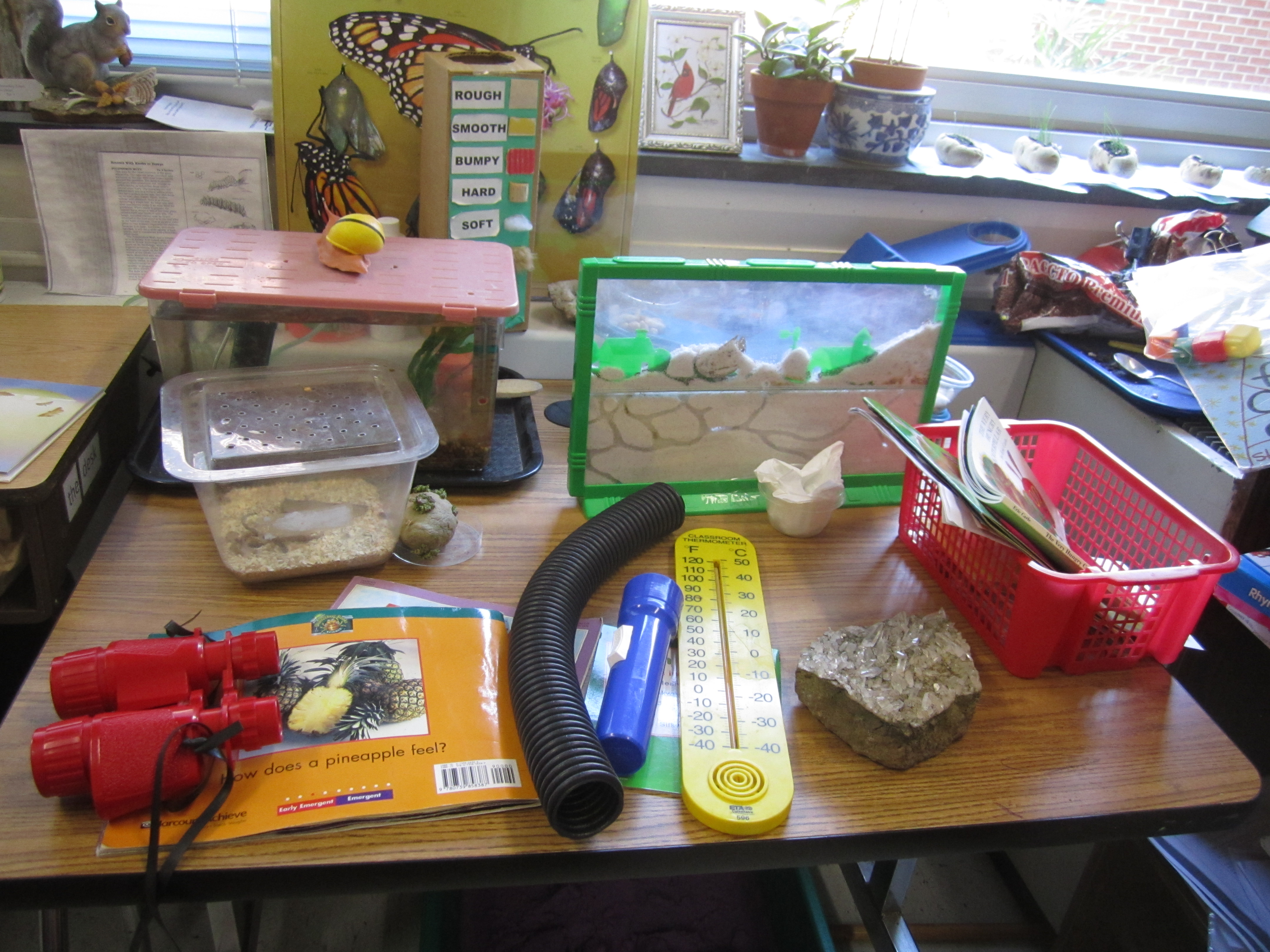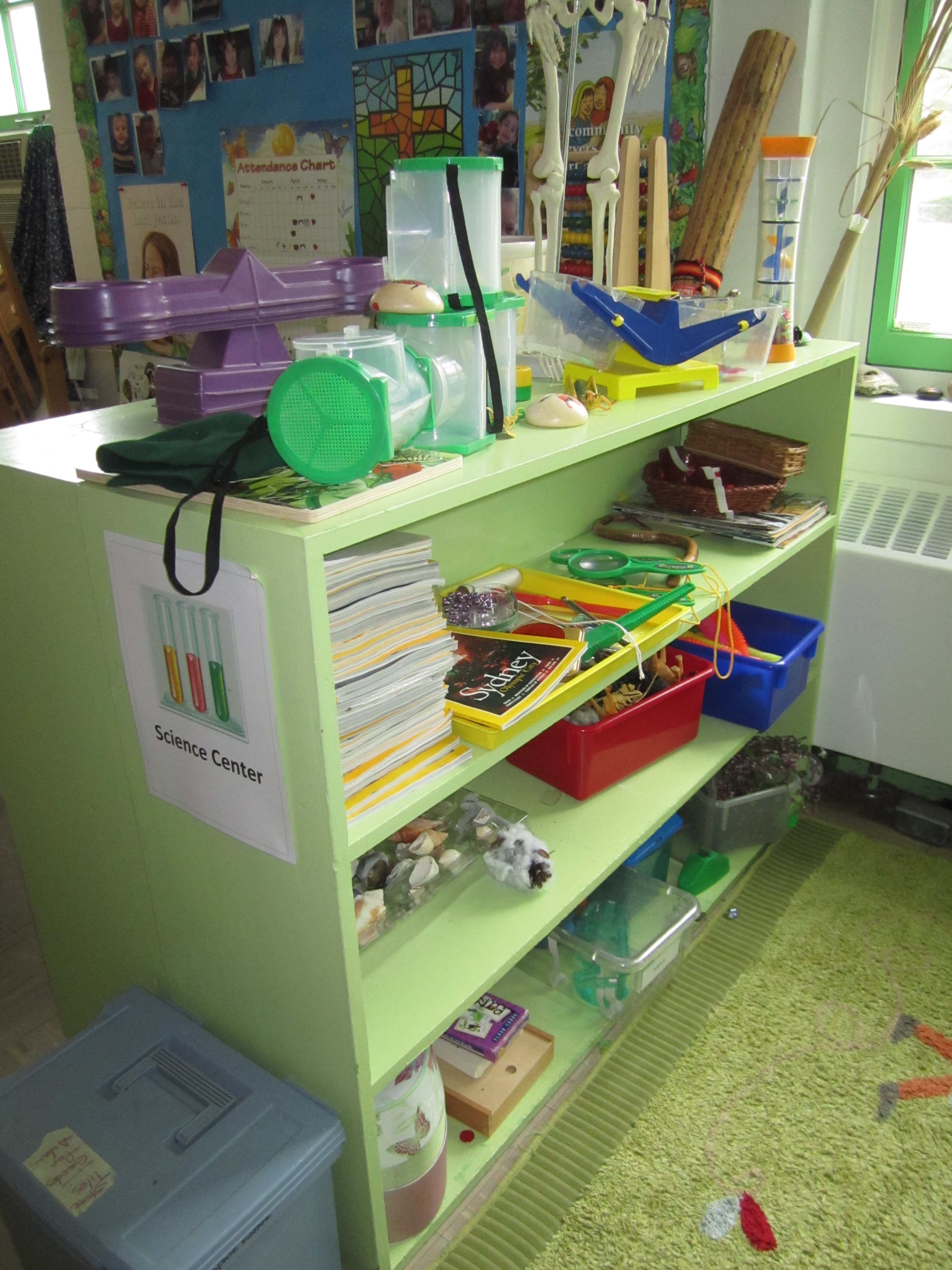Go Big with Vernier's Go Wireless pH Sensor
By Martin Horejsi
Posted on 2015-06-10
Go Big with Vernier’s Go Wireless pH Sensor
Dethethering is a fancy word for eliminating the cord. By going wireless the probe opens some interesting doors to creative and safe exploration and experimentation. One of the big advantages of a wireless probe is the same advantage we experienced with telephones and microscopes went cordless. No longer did we trip over cords, knock over containers when moving the cords, or dredging off the top of counter tops desks with the cord acting like a giant chain stripping the surface down to bare ground.
Goal-setting
By Mary Bigelow
Posted on 2015-06-09
 Our new principal wants us to come up with goals to accomplish in the next year. He hasn’t provided much guidance yet, so I don’t know what to do. How can I do this meaningfully? —J., Delaware
Our new principal wants us to come up with goals to accomplish in the next year. He hasn’t provided much guidance yet, so I don’t know what to do. How can I do this meaningfully? —J., Delaware
The end of the school year is a good time to reflect. This often leads to developing professional goals to improve your teaching and student learning. You probably have some in mind.
Working toward these goals can be an effective part of an individualized professional development plan. Unfortunately, goal setting is often an empty formality in my experience. I would definitely talk with your principal about his expectations.
I had a principal who required us to submit several goals each year. I suspect it was something he felt he had to do (or was told to do), but he did not provide any suggestions or examples on the number, format, or purpose. And he did not follow up on them during the year. Our professional development was not based on the goals, and they were not mentioned during any post-observation conferences. Because of this, I didn’t take the goal setting process seriously, treating it as a yearly task to check off the list. I certainly worked at becoming a better teacher, but those efforts were not formally related to the goals I submitted.
The process was different at another agency I worked for. Everyone, including the executive director, used the agency’s mission statement to formulate two to three SMART goals (the format is described below). We fine-tuned them with our supervisors and created an action plan to address them. At the mid-term and end of the year we discussed our progress and how the process was adding to our professional growth. It was a powerful form of professional development and a positive experience in reflection and self-evaluation.
Looking back, I realized my school district goals, as they were written, were not useful because they were extremely broad and lacked much purpose. The SMART acronym describes a more focused format:
- Specific: The goal is clearly stated with what you want to do, why it is important, and how it will be accomplished.
- Measurable: The goal describes the evidence you’ll use to determine your progress.
- Achievable: The goal is doable and realistic, given the resources that are available to you.
- Relevant: The goal relates to student learning and performance.
- Timely: The goal has target dates for achievement.
For example, “I want students to participate in class discussions” is a worthy but broad goal. It can be tweaked into a SMART goal:
- Specific: I will improve student learning by promoting active participation, using three strategies: calling on students randomly, using wait time, and incorporating turn-and-talk discussions.
- Measurable: I will use class observations (tally sheet of participants) as well as formative and summative assessment results.
- Achievable: The strategies require no additional resources or materials. I will read more on these strategies in professional publications.
- Relevant: The goal addresses student learning through equitable participation.
- Timely: The trial is one semester.
Here are some generic goal areas that could evolve into SMART goals:
Instructional Goals
- Incorporate inquiry into more lessons.
- Use strategies and assessments that focus on higher-level learning.
- Incorporate science notebooks.
- Implement new technology for ____.
- Prepare better substitute plans.
- Use a variety of formative assessments.
- Design lessons/units aligned with the Next Generation Science Standards (NGSS).
Interpersonal Goals
- Improve teacher-parent relationships, focusing on positive communications.
- Build better relationships with colleagues and other staff.
- Get to know students better.
Organizational Goals
- Establish routines for accessing and returning lab materials.
- Establish and maintain a classroom management plan, including expectations, routines, and rules.
- Improve documentation for various classroom situations.
- Keep up with inventories and other paperwork.
- Keep a record of lessons and units and put together notebooks or electronic files for each unit.
NSTA has a wealth of professional resources to help you meet your goals: online discussion forums and email lists, journals, books, conferences, the NGSS@NSTA Hub, free web seminars, and content-based courses.
Photo: https://www.flickr.com/photos/eclectic-echoes/6681499071/
Ecosystem experiences away from home
By Peggy Ashbrook
Posted on 2015-06-08
For children who visit the ocean beach or shore this summer, the experience of visiting a very different ecosystem can inspire interest in animals that inhabit it, and wonder about “how did it get this way?” Children who experience the beach and shore ecosystems frequently may have a similar reaction when visiting other ecosystems. How do we incorporate their questions and experiences into the classrooms in their home place?
 Some of us live in areas where we never see a sandy area in nature, much less a whole beach of it, so sand is a sensory experience rather than an exploration of the environment. Sand is a standard in early childhood programs because it feels so soothing as it pours through our fingers and we can build such interesting structures with wet sand. Sensory play provides a foundation for learning vocabulary, engaging socially with others, and learning about the properties of matter.
Some of us live in areas where we never see a sandy area in nature, much less a whole beach of it, so sand is a sensory experience rather than an exploration of the environment. Sand is a standard in early childhood programs because it feels so soothing as it pours through our fingers and we can build such interesting structures with wet sand. Sensory play provides a foundation for learning vocabulary, engaging socially with others, and learning about the properties of matter.
I’m thinking of some materials that can also be soothing and interesting yet be local, for my program:
 Leaves, dry or fresh, paired with scissors, or in water.
Leaves, dry or fresh, paired with scissors, or in water.- Dish soap bubbles in water (local as in every home).
- Rocks from a stream valley or landscape company (washed to remove pollutants that wash into streams.)
- Grass clippings if from a known pesticide- and fertilizer-free source.
Some of these materials may be appropriate for children of certain ages—you know your children. Some materials may only last for a day or two.
 To support children as they talk about their beach experiences on a trip away from home we can have a shell collection in the classroom to use for sorting, making impressions in playdough and incorporating into imaginative play. Edible seaweed is a wonderful sensory experience. It is sold in a dried form and becomes nicely slippery and wet when soaked in water. Not every child will want to do more than look at the wet seaweed but with teachers modeling how to touch it with first just one finger, more children may want to experience this interesting plant material. A fish bowl with a single goldfish or betta fish is not the same as the complex community of organisms found in the near shore ocean but it does give children a chance for up-close observation of an animal that lives in water. Children can mix salt into water, taste a few drops, and compare salt water to fresh water.
To support children as they talk about their beach experiences on a trip away from home we can have a shell collection in the classroom to use for sorting, making impressions in playdough and incorporating into imaginative play. Edible seaweed is a wonderful sensory experience. It is sold in a dried form and becomes nicely slippery and wet when soaked in water. Not every child will want to do more than look at the wet seaweed but with teachers modeling how to touch it with first just one finger, more children may want to experience this interesting plant material. A fish bowl with a single goldfish or betta fish is not the same as the complex community of organisms found in the near shore ocean but it does give children a chance for up-close observation of an animal that lives in water. Children can mix salt into water, taste a few drops, and compare salt water to fresh water.
In a July 11, 2012 post, “Going to the Beach?,” I shared this resource and other early childhood educators commented and contributed more ideas: Writer and scientist Ann McElhatten, shares her knowledge of Atlantic seacoasts in a free e-book, 10 Beachcombing Activities: A guide for investigating the Atlantic coast shoreline.
Talking with children and helping them reflect on, and perhaps draw or paint, what they observed. This extends children’s thinking about experiences in any ecosystem. What did you do there? What animals did you see? How did the ground feel? Was there water? What plants did you see? What smells did you sniff? What kind of weather did you experience? Was it warm or cold, or both?
 For those educators who do live near a marine ecosystem, the National Marine Educators Association’s (NMEA) annual conference is happening June 29 through July 2 at the Newport Marriott, in downtown Newport, Rhode Island. Formal and informal marine educators from across the U.S. and around the world will come together to help promote the mission of “making known the world of water, both fresh and salt.”
For those educators who do live near a marine ecosystem, the National Marine Educators Association’s (NMEA) annual conference is happening June 29 through July 2 at the Newport Marriott, in downtown Newport, Rhode Island. Formal and informal marine educators from across the U.S. and around the world will come together to help promote the mission of “making known the world of water, both fresh and salt.”
For children who visit the ocean beach or shore this summer, the experience of visiting a very different ecosystem can inspire interest in animals that inhabit it, and wonder about “how did it get this way?” Children who experience the beach and shore ecosystems frequently may have a similar reaction when visiting other ecosystems. How do we incorporate their questions and experiences into the classrooms in their home place?
ExploraVision Awards Weekend 2015
By Lindsey Reichert
Posted on 2015-06-08
Someone in your family loses their hearing aid…again! But it’ no problem, you just print a new one on your 3D printer and life goes on seamlessly. Sound too good to be true? Not for long, in the world envisioned by young scientists who were honored last weekend during the 23rd annual Toshiba/NSTA ExploraVision awards weekend.
The National Science Teachers Association (NSTA), along with Toshiba celebrated the national student winners for their hard work and creative ideas in science and technology. The Toshiba/NSTA ExploraVision program challenged participants to imagine what technology might be like in 20 years. Students worked in teams to propose ideas for innovative future technology based on a challenge of what already exists, simulated real scientific research to outline how they planned to test their idea, and built websites to further illustrate and communicate their concepts.
This year, more than 5,000 team projects were entered into the competition representing 15,473 students from across the United States and Canada. First place winning projects included the S.T.A.R. Sea Turtle Assistance Rod (Grade K-3), The Green Tablet (Grade 4-6), Survival of the Freshest: Preservation of Organic Food (Grade 7-9), and Programmable Bio-Scaffolding: The Suture of Future (Grade 10-12). This year’s second place winners were SportaVision (Grade k-3), Clarite- A Better Cochlear Implant (Grade 4-6), Heat Utilizing Hearing Aids (Grade 7-9) and External Microbial Cleansing Device – EMCD (Grade 10-12).
All students from the eight first and second place teams received savings bonds and an exciting expenses-paid trip with their families, mentor and coach to Washington, D.C. Activities included a visit to Capitol Hill to meet with members of Congress and a Science Showcase where students displayed and demonstrated their winning ideas. The highlight of the Toshiba/NSTA ExploraVision weekend was the gala awards banquet and ceremony where students were formally recognized for their creativity and accomplishments.
At the STEM Education Science Fair that took place on Thursday in the Rayburn House office Building, finalists showcased their projects to members of Congress and their staff. This informal event provided members of Congress and their staff with the opportunity to see first-hand the benefits and importance of STEM education. The kids loved engaging with these important men and women and were excited to share their ideas and projects. The atmosphere was upbeat and lively; students were even taking selfies with their Congressmen!
The students then attended the Senates STEM Panel and were able to meet with Senators from their home state.
The fun continued on Friday with the National Press Club Science Showcase. You can probably hear the theme song now… because everyone’s favorite man in science, Bill Nye the Science Guy was there! The kids loved meeting him and explaining their projects during the satellite media interviews that were broadcasted in their hometowns. After this, the eight winning teams presented their projects to NSTA leadership and high-level Toshiba executives. In their interaction, many of the Toshiba executives explained their hope that one day these young scientists might join their company!
The Gala Awards Banquet, which took place Friday night, was the pinnacle event. The night started with students being congratulated with a “live broadcast” from Times Square. They also had the incredible opportunity to listen to a past winner from 1998 –Dr. Kim Ly – speak about her experience with the competition; and Bill Nye encouraged them to “change the world.” The students were then welcomed to the stage to individually receive their awards and the night ended with confetti, cannons and music as we celebrated science and innovation.
View our Facebook album to see more, and if you were there and see yourself, please tag yourself.
That’s wrap! We’re ending #ExploraVision weekend with confetti! pic.twitter.com/3MmKIJXEsw
— Toshiba Innovation (@ToshibaInnovate) June 6, 2015
Author Lindsey Reichert works with the National Science Teacher’s Association with the Communications, Legislative, and Public Affairs Team. e-mail her at lreichert@nsta.org.
The mission of NSTA is to promote excellence and innovation in science teaching and learning for all.
Follow NSTA
Legislative Update
America COMPETES Act Reauthorization
By Jodi Peterson
Posted on 2015-06-07
Earlier this spring the U.S. House of Representatives passed the America COMPETES Act Reauthorization Act of 2015 (HR 1806) by a vote of 217-205, with 23 Republicans joining every Democrat present in voting against the bill.
The bill was strongly opposed by a number of groups—including the Association of American Universities, Computing Research Association, American Geophysical Union and the Consortium of Social Science Associations—who claim the legislation sets false priorities for the science agencies and would limit research.
Read more about the opposition to the America COMPETES Act.
The Administration also strongly opposes the legislation, saying it “would undermine critical investments in science, technology, and research” and “would be damaging to the Administration’s actions to move American competitiveness, innovation, and job growth forward through a world-leading science, technology, and innovation enterprise.”
Read the America COMPETES Reauthorization Act of 2015 (H.R. 1806): Impact on the National Science Foundation.
In regards to STEM education, the bill would seek to coordinate and improve the extensive portfolio of STEM education programs at the different federal agencies by creating a new function at the National Science Foundation. It would also work to coordinate STEM education activities conducted across the government with a new federal STEM Education Advisory Panel.
Read the STEM Education Coalition statement on the bill.
In the Senate, a bipartisan group of seven senators introduced legislation which would reauthorize the energy title of the America COMPETES Act. In contrast to the House bill, according to Politico, the proposed Senate COMPETES legislation “seeks to lay out funding through fiscal 2020 and provide steady increases each year. Meanwhile, the House bill, which also covers broader funding needs at the National Science Foundation and other non-Energy Department programs, would keep funding levels flat across the board and stops at fiscal 2017.”
Update on Elementary and Secondary Education Act
Still no definitive word on when the respective House and Senate bills to reauthorize the Elementary and Secondary Education Act (No Child Left Behind) will move forward in both chambers for final amendments, consideration, and passage. Many believe (hope) the bills will be taken up by both bodies by the end of June.
Stay tuned and look for upcoming issues of NSTA Express for the latest information on developments in Washington, D.C.
Jodi Peterson is Assistant Executive Director of Legislative Affairs for the National Science Teachers Association (NSTA) and Chair of the STEM Education Coalition. e-mail Jodi at jpeterson@nsta.org; follow her on Twitter at @stemedadvocate.
The mission of NSTA is to promote excellence and innovation in science teaching and learning for all.
Follow NSTA
The STEM in Bagels
By Becky Stewart
Posted on 2015-06-03
On a recent trip to visit friends in Lewes, Delaware, I had a bagel from Surf Bagels for the first time. This delicious and perfectly constructed bagel got me thinking about how they are produced. It turns out there are a number of STEM topics in bagel baking and production.
Bagels have a long history in Middle Eastern and European baking. They are a close relative of soft pretzels. Despite their long history, these delicious and almost ubiquitous breakfast breads were not well known in the United States, outside of the greater New York City metropolitan area, before the 1950s. Murray Lender came up with the idea of freezing bagels to improve his production schedule. Demand for bagels was very high on the weekends but very low the rest of the week. This meant his bakers worked highly irregular hours. Lender decided that freezing the bagels would let him spread out production across the week and would be more efficient. This also allowed bagels to spread across the country, because they would keep much longer in frozen form than they would if shipped fresh. The other big technological innovation in mass production was the bagel-shaping machine, perfected at about the same time by Daniel Thompson. Murray Lender leased the first production-scale machine from Thompson.
Bagel making is traditionally a two-step process. Hand-made bagels are boiled before they are baked, and this sets a crust on the outside of the bagel. The water does not soak into the bagel because the starch in the dough forms a gel in the hot water, which seals the surface of the bagel. The crust prevents the bagels from rising while they bake, and this makes bagels dense and chewy. There’s more to it than that, though, because the boiling water is made alkaline on purpose, to intensify the Maillard reaction and make the bagels brown quickly when they are baked.
If you’re teaching acids and bases in chemistry, you could try making bagel dough in your classroom and talking about why alkaline water has this effect on the Maillard reaction. If you boil half of them in a dilute solution of lye and half of them in water to which you’ve added baked baking soda, you could compare them to see what differences there are in the finished product.
Does the Water Make the Bagel?
The water used to boil the bagels may have other effects, too. There is some debate about where the best bagels in the United States can be found, but the general consensus is that New York City produces the best bagels. Most people think the reason for that is in the municipal water supply. New York City’s water comes from reservoirs in the Catskill Mountains, and the watersheds of those reservoirs are protected. The city’s water treatment plants are not required to filter the water because it is so pure, and this leaves more minerals in the water than in many other places. Specifically, the ratio of calcium to magnesium in the city’s water may affect the gluten in the dough. The question of how much influence the city’s water has on the bagels boiled in it is a source of debate.
New York City’s water system is the largest in the country, and it delivers 1.2 billion gallons of water per day. The water comes into the city in a system of aqueducts and tunnels. The largest tunnel was begun in 1970 and is not expected to be finished until 2021. The water comes from two sources, the Croton Watershed and the Catskill/Delaware Watershed. The Croton Watershed supplies 10% of the city’s water and has a filtration system. There is a debate about whether the city’s water can continue to be unfiltered. Upstream development in the Catskill/Delaware Watershed is having an effect.
Why Mass-Produced Bagels Just Aren’t the Same
Mass-produced bagels are usually steamed instead of boiled. Boiling the bagels before baking them is a process that does not lend itself to mass production. It is time consuming, and equipment large enough to boil a lot of bagels is expensive. Mass-produced bagels may also contain additives that keep the dough from sticking to the machines. It is possible to make bagels the traditional way on a large scale but it is not that common yet. There are too many people who think that bagels should be pale doughy toroids.
Bagel Math
Luckily for all of us, however, bagels are not that difficult to make at home. The formed bagels do have to be refrigerated overnight, so you need a cold place to keep them on their trays. Other than the obvious mathematical wonder of how many bagels one teenage boy can eat, there is useful math that can be done in the name of bagels. You could amaze some math teachers with this method for cutting bagels into a Möbius strip, thereby maximizing the surface area for spreading with cream cheese. If you’re really into math (and bagels) you could try slicing a bagel into 13 pieces with just three cuts. For a more interactive kind of entertainment, try Bagels Pico Fermi (a variant of the old board game Mastermind) with your class.
Produced by the National Science Teachers Association (NSTA), science writer Becky Stewart contributes monthly to the Science and STEM Classroom e-newsletter, a forum for ideas and resources that middle and high school teachers need to support science, technology, engineering, and math curricula. If you enjoy these blog posts, follow Becky Stewart on Twitter (@ramenbecky). Fans of the old version of The STEM Classroom e-newsletter can find the archives here.
Follow NSTA
On a recent trip to visit friends in Lewes, Delaware, I had a bagel from Surf Bagels for the first time. This delicious and perfectly constructed bagel got me thinking about how they are produced. It turns out there are a number of STEM topics in bagel baking and production.
Systems: "Science Areas" and lining-up for transitions
By Peggy Ashbrook
Posted on 2015-05-31
Organizing systems for materials and people are necessary for a productive day in school. If they are held in common by the school or classroom community they operate smoothly. Sometimes changes made by an individual interrupt the flow. In those moments we can re-consider our systems and decide whether to keep the changes or return to the original plan.
Here are some systems that I’ve seen in preschools and the questions that I’ve been considering about them. You can help me think about these systems by adding a comment below to share your own questions or advice.
Science centers
Systems can identify areas for particular tools and activities, providing children with the materials and space they need for particular kinds of play–creating artwork and writing, playing dress-up and telling stories, reading a book, building a block structure in a protected space, and using tools to look at living organisms. Some curricula require certain centers or areas, and signs to identify them: Housekeeping, Art, Blocks, Writing, Circle, Library and Science. Having a print-rich environment, including signage, is part of developing children’s literacy.
By posting an area as the “Science Area,” early childhood educators may promote teaching science by making teachers, children and parents aware that science education is part of the curriculum. Identifying science learning as a part of the daily routine teaches children that they can participate in science. But do we need to have a “Science Center”? The word “Science” is visible; however, the label might make us unconsciously limit where science investigations happen, and therefore not integrate thinking about science concepts into the daily schedule. Examining the shapes of and sorting a box of seashells, combining sets of blocks to build a “super big” rocket, experiencing the properties of matter while working in the sensory table or making playdough—science (and engineering) explorations happen in all parts of a classroom not only in a center. Should there also be “Technology,” “Engineering,” and “Math” areas if a program uses the acronym “STEM” to describe the curriculum?
A “Science Area” is a handy place to store or display a rock collection, set of x-rays, or a terrarium but do those displays invite children to interact with the materials and do they ever change? How do you keep the area fresh and interesting? How do you make participation in science and engineering practices and thinking about concepts part of your everyday routine?
Systems for lining up students to move to another space
Transitions from one space to another take time. Accepting this is one way to lessen feelings of frustration. We can also create systems to make these times shorter, fun, opportunities for connecting socially, and learning opportunities. Here is one system that is used by a class of four-year-olds to move from the classroom to the playground and back again, making sure all children are there.
 The numbers from 1 to 18 are posted on the floor in the place to line up, both in numerals and the same number of object pictured on the same square. The teachers have a paper listing children’s names with spaces next to them on a clipboard. Every day teachers pencil in a new order of numbers next to the names. The numbers move down a space and the last number moves to the first
The numbers from 1 to 18 are posted on the floor in the place to line up, both in numerals and the same number of object pictured on the same square. The teachers have a paper listing children’s names with spaces next to them on a clipboard. Every day teachers pencil in a new order of numbers next to the names. The numbers move down a space and the last number moves to the first  name in the list. The children line up on the squares according to their place that day. They verify their spot by reading the numeral or counting the objects. In the beginning, the children need reminders about which number they “are” that day. Since they line up several times a day, five days a week, they soon remember where they were the day before and place themselves accordingly. If the interactions between children in line become disruptive, the order can be changed by drawing numbers or teacher choice. Children become familiar with the numerals, counting sets and participating in a system for moving people.
name in the list. The children line up on the squares according to their place that day. They verify their spot by reading the numeral or counting the objects. In the beginning, the children need reminders about which number they “are” that day. Since they line up several times a day, five days a week, they soon remember where they were the day before and place themselves accordingly. If the interactions between children in line become disruptive, the order can be changed by drawing numbers or teacher choice. Children become familiar with the numerals, counting sets and participating in a system for moving people.
Many, many more systems for lining up are available online by searching for “how to line up in preschool”. The New Mexico PreK Resources page on Transitions with information from High Scope sources asks us to consider why children need to line up. Does your system work well?
Organizing systems for materials and people are necessary for a productive day in school. If they are held in common by the school or classroom community they operate smoothly. Sometimes changes made by an individual interrupt the flow. In those moments we can re-consider our systems and decide whether to keep the changes or return to the original plan.
Here are some systems that I’ve seen in preschools and the questions that I’ve been considering about them. You can help me think about these systems by adding a comment below to share your own questions or advice.
Science for all
By Mary Bigelow
Posted on 2015-05-30
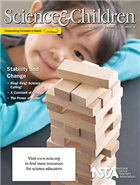
The most recent NSTA K-12 journals have suggestions, lesson ideas, and resources for helping all students engage with the disciplinary content, crosscutting concepts, and science and engineering practices that make up the NGSS.
Science & Children — Stability and Change
Although this may sound like an oxymoron (“the more things change, the more they stay the same?”), this is actually one of the NGSS crosscutting concepts. It’s one that would be appropriate for many topics in the general sciences: Newton’s Laws, equilibrium, food webs, body systems, weather and climate, plate tectonics, other systems studies.
Here are some SciLinks with weblinks for content information and suggestions for additional activities and investigations related to this month’s featured articles:
- Ring! Ring! Science Calling! [SciLinks: Genetics]
- A Constant of Change [SciLinks: Sun]
- What Happens When An Environment Changes? [SciLinks: Food Chains
- The Power of Water [SciLinks: Water Erosion, Severe Storms]
- Teaching Through Trade Books: The Earth’s Changing Surface [SciLinks: Dynamic Earth, Water Erosion, Earthquakes, What processes change landforms?]
- Formative Assessment Probes: No More Plants [SciLinks: Ecosystems, Food Chains and Food Webs]
- Methods and Strategies: Garden-Based Learning: It’s Just the Berries! [SciLinks: Factors Affecting Plant Growth]
- Science 101: How Does Stable Equilibrium Differ From Other Kinds of Equilibrium? [SciLinks:
- The Early Years: Recognizing Stability and Change [SciLinks: What Are Systems?]
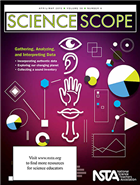 Science Scope — Gathering, Analyzing, and Interpreting Data
Science Scope — Gathering, Analyzing, and Interpreting Data
The lessons described here (many of which illustrate the 5E model), illustrate the integration of NGSS disciplinary core ideas and crosscutting concepts with science and engineering concepts related to the collection, analysis, interpretation, and communication of data. The articles feature traditional methods as well as technology software and apps.
Here are some SciLinks with weblinks for content information and suggestions for additional activities and investigations related to this month’s featured articles:
- Using the Scientific Process to Engage Students With Our Changing Planet [SciLinks: Changes in Climate, Changes in Ecosystems, Biotic and Abiotic Factors, Ecosystems]
- Exploring Sound! Using Tablets in Middle School Science [SciLinks: Properties of Sound, Sound Quality]
- Using Authentic Data to Enhance Middle School Atmospheric Science Instruction [SciLinks: Tornadoes, Severe Weather, Storms]
- “Nor Any Drop to Drink” Students Engineer Solutions for Desalinating Ocean Water [SciLinks: Desalination, Water Quality]
- Teaching With Tarantulas [SciLinks: Arachnida]
- Let Them Eat Cake …OE-Cake! [SciLinks: Phase of Matter, Density]
- Tried and True: The Science of Bending Light [SciLinks: Refraction, Properties of Light]
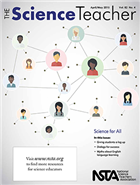 The Science Teacher — Science for All
The Science Teacher — Science for All
As the editor notes, “More often than not, high-quality teaching strategies like those in this issue benefit students well beyond the targeted group.” There are many suggestions for including all students in learning science, including special needs students and English language learners.
Here are some SciLinks with weblinks for content information and suggestions for additional activities and investigations related to one of this month’s featured articles:
- Making Molecular Movies [SciLinks: Polymers]

The most recent NSTA K-12 journals have suggestions, lesson ideas, and resources for helping all students engage with the disciplinary content, crosscutting concepts, and science and engineering practices that make up the NGSS.
Science & Children — Stability and Change
Based on the award-winning, best-selling Picture-Perfect STEM series, this ClassPack pairs effortlessly with the Picture-Perfect STEM Grade 1 Lesson "Sunset and Shadow Play" to combine reading comprehension, literacy, and science in your classroom! Corresponding lesson Children's Book Packs are available for purchase seperately.
Based on the award-winning, best-selling Picture-Perfect STEM series, this ClassPack pairs effortlessly with the Picture-Perfect STEM Grade 1 Lesson "Sunset and Shadow Play" to combine reading comprehension, literacy, and science in your classroom! Corresponding lesson Children's Book Packs are available for purchase seperately.






